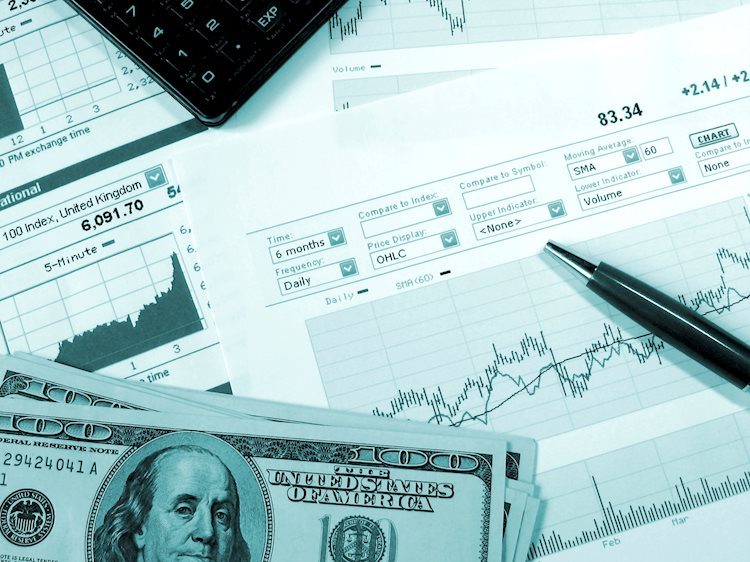- The US Dollar snaps this week’s losing streak and claws back.
- Traders are sitting on their hands ahead of GDP and PCE inflation data later this week.
- The US Dollar Index locks in above 104.00 and is expected to defend this level ahead of the pivotal data.
The US Dollar (USD) sees Dollar Bulls digging in their heels on Wednesday, holding to recent gains and ending the losing streak for this week so far. Markets are not really seeing a main driver for the turnaround, so this move should be taken with a pinch of salt. This could result in the Greenback trading in a tight range until the release of important economic data later this week, namely the US Gross Domestic Product (GDP) on Thursday and the Personal Consumption Expenditures (PCE) Price Index, the Fed’s preferred inflation gauge, on Friday.
A very light US calendar is ahead on Wednesday, with only the Mortgage Bankers Association delivering its weekly Mortgage Applications for this week. Markets will be able to hear from a Fed official as Fed Board Member Christopher Waller will deliver a speech about the US Economic Outlook at the Economic Club of New York. Known for being a hawk, any change in the number of interest-rate cuts or timing could be important for the Greenback’s valuation.
Daily digest market movers: Lighter than light
- The Mortgage Bankers Association has released the weekly Mortgage Applications Index for this week at 11:00 GMT. The previous number showed a 1.6% contraction compared with a week earlier, and this week was no different with a contraction by 0.7%.
- The US Treasury is issuing another bond, this time in the 7-year tenor at 17:00 GMT.
- Fed Board Member Christopher Waller will speak about the US Economic Outlook at the Economic Club of New York around 22:00 GMT.
- Equities are overall in the green, except for China, where both the Hong Kong Hang Seng Index and the Shenzhen Index have retreated over 1%. European and US equities are in the green by 0.25% on average.
- According to the CME Group’s FedWatch Tool, expectations for the Fed’s May 1 meeting are at 88.3% for keeping the fed funds rate unchanged, while chances of a rate cut are at 11.7%.
- The benchmark 10-year US Treasury Note trades around 4.22%, a touch softer from Tuesday’s high at 4.27%.
US Dollar Index Technical Analysis: Trenches and fortresses around 104.00
The US Dollar Index (DXY) is entrenching itself (or at least the Dollar bulls are) above 104.00. Shovels and pitchforks are used by traders to make sure that the Greenback does not retreat below 104.00, with the idea that both US GDP and PCE data will beat expectations, favoring a stronger US Dollar. It appears some conviction is creeping in the markets that the US economy will keep soaring, together with a return of inflation. This, in turn, means that the Fed wouldn’t need to cut interest rates three times this year as the economy would be on a path for a soft landing.
That first pivotal level for the DXY is near 104.60, where last week’s rally peaked. Further up, 104.96 remains the level to beat in order to tackle 105.00. Once above there, 105.12 is the last resistance point for now before the Relative Strength Index (RSI) will trade in overbought levels.
Support from the 200-day Simple Moving Average (SMA) at 103.74, the 100-day SMA at 103.48, and the 55-day SMA at 103.64 are unable to show their importance as support because traders didn’t wait for a drop to those levels for a turnaround. The 103.00 big figure looks to remain unchallenged for longer, after the decline in the wake of the Fed meeting last week got turned around way before reaching it.
Central banks FAQs
Central Banks have a key mandate which is making sure that there is price stability in a country or region. Economies are constantly facing inflation or deflation when prices for certain goods and services are fluctuating. Constant rising prices for the same goods means inflation, constant lowered prices for the same goods means deflation. It is the task of the central bank to keep the demand in line by tweaking its policy rate. For the biggest central banks like the US Federal Reserve (Fed), the European Central Bank (ECB) or the Bank of England (BoE), the mandate is to keep inflation close to 2%.
A central bank has one important tool at its disposal to get inflation higher or lower, and that is by tweaking its benchmark policy rate, commonly known as interest rate. On pre-communicated moments, the central bank will issue a statement with its policy rate and provide additional reasoning on why it is either remaining or changing (cutting or hiking) it. Local banks will adjust their savings and lending rates accordingly, which in turn will make it either harder or easier for people to earn on their savings or for companies to take out loans and make investments in their businesses. When the central bank hikes interest rates substantially, this is called monetary tightening. When it is cutting its benchmark rate, it is called monetary easing.
A central bank is often politically independent. Members of the central bank policy board are passing through a series of panels and hearings before being appointed to a policy board seat. Each member in that board often has a certain conviction on how the central bank should control inflation and the subsequent monetary policy. Members that want a very loose monetary policy, with low rates and cheap lending, to boost the economy substantially while being content to see inflation slightly above 2%, are called ‘doves’. Members that rather want to see higher rates to reward savings and want to keep a lit on inflation at all time are called ‘hawks’ and will not rest until inflation is at or just below 2%.
Normally, there is a chairman or president who leads each meeting, needs to create a consensus between the hawks or doves and has his or her final say when it would come down to a vote split to avoid a 50-50 tie on whether the current policy should be adjusted. The chairman will deliver speeches which often can be followed live, where the current monetary stance and outlook is being communicated. A central bank will try to push forward its monetary policy without triggering violent swings in rates, equities, or its currency. All members of the central bank will channel their stance toward the markets in advance of a policy meeting event. A few days before a policy meeting takes place until the new policy has been communicated, members are forbidden to talk publicly. This is called the blackout period.
Information on these pages contains forward-looking statements that involve risks and uncertainties. Markets and instruments profiled on this page are for informational purposes only and should not in any way come across as a recommendation to buy or sell in these assets. You should do your own thorough research before making any investment decisions. FXStreet does not in any way guarantee that this information is free from mistakes, errors, or material misstatements. It also does not guarantee that this information is of a timely nature. Investing in Open Markets involves a great deal of risk, including the loss of all or a portion of your investment, as well as emotional distress. All risks, losses and costs associated with investing, including total loss of principal, are your responsibility. The views and opinions expressed in this article are those of the authors and do not necessarily reflect the official policy or position of FXStreet nor its advertisers. The author will not be held responsible for information that is found at the end of links posted on this page.
If not otherwise explicitly mentioned in the body of the article, at the time of writing, the author has no position in any stock mentioned in this article and no business relationship with any company mentioned. The author has not received compensation for writing this article, other than from FXStreet.
FXStreet and the author do not provide personalized recommendations. The author makes no representations as to the accuracy, completeness, or suitability of this information. FXStreet and the author will not be liable for any errors, omissions or any losses, injuries or damages arising from this information and its display or use. Errors and omissions excepted.
The author and FXStreet are not registered investment advisors and nothing in this article is intended to be investment advice.






